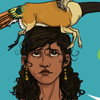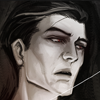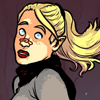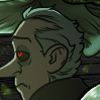The Webcomic Overlook #68: Loviathan

What’s there to love in the world of webcomics? I can probably recite a whole list of things. Today, though, I’d like to express my deep love for the Act-I-Vate collective. I love, love, love their “Comix” section. Every time I pull up the page, I feel like I’ve been immediately transported to a comic book shop and I’m looking at the indie comics rack. I mean, look at all these covers and all these oddball genres! As an added plus, every single one of the titles look like they were done by established comic professionals, the sort of folks who are blase about having Eric Larsen’s or Dan Didio’s name in their rolodex.
So for Webcomic Overlook #68, I thought it would be great to do a review on one of the comics featured in Act-I-Vate. Which one did I choose? Was it one of Dean Haspiel’s highly acclaimed Billy Dogma comics? Was it the quirky indie romance of Bee? The visually stunning former Zuda contender, Sam & Lilah? Or the intriguingly titled Party Bear?
Nope. I selected the comic whose cover features costumed characters, namely a fetching young lass in the arms of an albino elf. So know you know the terrible secret of The Webcomic Overlook: El Santo is as predictable as any typical comic book fanboy, especially when it comes to promo art that approaches geek nirvana. (Immutable geek theorem: everything’s better with pointy ears.)
Still, it’s only appropriate that, on the week before Valentine’s Day, I review a comic named Loviathan, which comes with the cheeky tagline: “Love is the End of the World.” It’s written and illustrated by Mike Cavallaro.

Cavallaro has a long, impressive resume. His bio page indicates that he’s “worked in comics and animation at DC Comics, Valiant Comics, Milestone, Image, BOOM! Studios, MTV Animation, Cartoon Network and others.” Also, he’s dabbled in webcomics. His most acclaimed work thus far is perhaps Parade (With Fireworks), which is also hosted at Act-I-Vate. This story of a man living it Italy during the two World Wars garnered a 2008 Eisner nomination.
Loviathan, by the way, is not quite so serious. It’s like Mike’s saying, “Dammit, time to unwind. I can drink a Scotch or draw more comics, and I’m all out of Scotch.”
The star of Loviathan is the aforementioned long-haired albino elf who goes by the name of Elric of Melniboné. No, wait… according to my notes, his name is actually “Llyr.” My bad. Loosely translated, “Llyr,” I think, means “I slammed my keyboard on my desk and this is the name I got.” Llyr is the King of Atlantis. As comic fans of DC and Marvel can attest, that’s a terrible career choice. You’re going to end up either amputated with your hand replaced by a harpoon or doomed to run around New York City in nothing but scaly green bikini briefs.
As the story, we see Llyr grappling with what looks to be some sort of nega-Llyr, a similarly costumed guy with pointy ears, but with black hair this time. Nega-Llyr turns out to be … wait for it … Llyr’s evil brother, Ultan! The whole evil brother thing gets a lot of play, but damn it if li’l Ultan doesn’t remind me of good old Loki. The two appear out of thin air in modern day New York… Brooklyn Bridge, to be exact. The two are shocked by the sudden change in their surroundings. Before either can totally absorb the magnitude of their situation, though, a subway train barrels at them from out of nowhere. Llyr takes a dive into the clean, crisp waters of the East River.

Uther, meanwhile, hops onto a passing train, perhaps to catch a Mets game. In a nice touch, gets mistaken as a homeless man. Of course, that begs the questions: what the hell sort of homeless people do they have in New York these days? Sure, Ultan’s been standing out in the rain, and he looks a tad bedraggled. The guy’s still wearing a suit of armor and a cape, though. If anything, I’d assume the guy was headed to New York Comic Con. So unless Atlantean armor is composed of cardboard boxes and glue, I’m going to assume that the homeless of Loviathan‘s New York look like Roman legionnaires.
Remember, though, this comic isn’t called BROviathan. Llyr’s lady love (whoa! say that three times fast!) is a gal named Ainé. She’s pure Kirby, this one, looking like an amalgam of Sif from Thor and Big Barda from the New Gods. As he plunges into the water, Llyr glances upon a woman staring back at him on a subway train. She has a familiar air about her. Could she be his long lost queen? Where has she disappeared to all this time?
From what’s revealed thus far, the woman who might be Ainé seems to have spent some time on the surface world in the intervening years. Her days were spent running a cult called “The Church of the Abyss” in Wyoming. The cult was shut down by federal agents, who then forcibly convinced her that there were no such thing as fishmen. Our mysterious lady also has a son who seems to be experiencing weird visions. But what can you expect from someone who may be the long lost heir-apparent of Atlantis?
And incidentally, why do people doubt the existence of Atlanteans when they fully accept the existence of lady pirates?

Loviathan is all about the Silver Age. Long-time comic fans might recognize Calavarro’s style as a direct homage to only the most important comic artist of all time: Jack Kirby. You’ve got the heavy dark shadows to give drawing a sense of solidity. You’ve got the geometrically simple costumes straight from a New Gods rummage sale. And you’ve got designs so absurd that it’s borderline genius. I’m talking about the whales with cannons strapped on their backs.
Does Cavalarro stop the retro love with the art? Not so, true believers! Maniacal Mike channels yet another ubiquitous remnant of the gilded age of superheroes: the expositional dialogue. The first few pages of each chapter are dominated by lines and lines of purple prose. This explanation-point-happy passage, for example (emphasis Mike’s):
A hateful rain of destruction poinds the city’s protective dome! Above, the War Whales of Orolus circle ominously! Below, the marching feet of a million Fire Trolls shake the rainbow towers of living coral! Mu! Abyssia! Lemuria! Even the Sister Cities, Jumneta and Vineta! All have fallen before the voracious armies of Orolus, volcanic God of Brimstone and Fire! Now here, to regal Atlantis, richest jewel in all the Seascape, have the refugees fled — only to find themselves trapped again by the same merciless ring of fire!
It’s the sort of faux Shakespeare that Stan Lee used to do in the pages of Marvel to scam readers into thinking that they were actually smart. It’s a cute homage. Heck, it might based on actual legend: I recognized “Mu,” at least. (Only because it plays a prominent role in the RahXephon anime. Sigh.) Cavallaro, though, forgets that we only let Smilin’ Stan get away with it because we all knew that the man was bats*** insane. Needless to say, we were more than a little afraid that we if did anything but smile and nod our heads, Stan would go off and create a stripper-based superhero, or host a reality show featuring cosplayers going by names like “Fat Mama” and “Cellphone Girl”, or think that Ravage 2009 was actually a good idea. Homage or not, purple prose is horribly unreadable. My eyes glazed until the shouty textboxes finally disappeared.

Now, I like Loviathan enough, mind you. It just feels so … disposable. Jack Kirby tribute works come and go in comicdom. Remember that Alan Moore series he wrote for Image Comics called 1963? Of course you don’t. The series featured thinly-clad versions of the Silver Age Marvel Heroes. Mystery Inc. was the Fantastic Four, Horus: Lord of Light was Thor, and The Fury was Spider-Man. It was fun while it lasted, but it was disposable fun… good for a short laugh, but then your forgot all about it 15 minutes later after it was all over. And this was Alan Moore, mind you, they guy who most people (not me) think can turn comic books to gold using his wizard powers.
I get a similar vibe from our beloved Thor/Submariner/Aquaman hybrid. The Kirby art is neat, but no new ground is being broken (and it certainly doesn’t surpass the power of the originals). The characters are all one-dimensional. The villains are barely more than cackling — pardon the expression — comic book villains. Our hero almost always has his face pulled in a grimace, and frankly there have been times I’ve wanted to punch him in the kisser for looking so smug. (Which is funny, because his “son” also has a very smug and punchable face, thus dispelling any questions of parentage.) The only thing sustaining Loviathan is the goofy nostalgia. Maybe that’s all Cavalarro wants, which is fine … it’s just that I’ll probably forget all about this comic by the time I read something meatier, like, say, Anders Loves Maria.
Then again, there have only been two issues thus far. There is a potential that, if it lasts long enough, Loviathan can evolve in the same way as Venture Brothers. Don’t forget, that show started off as a Johnny Quest parody that turned into an eminently watchable series through the strength of its clever writing and interesting characters. Can Mike Cavarallo get El Santo to love Loviathan? Tune in next time, heroes!
Rating: 3 stars (out of 5)



Posted on February 8, 2009, in 3 Stars, action webcomic, adventure webcomic, superheroes, The Webcomic Overlook, WCO Big Review, webcomics and tagged Act-I-Vate, Loviathan. Bookmark the permalink. 3 Comments.












































































































Nice review. In fact I’ve been trawling your archives and all the reviews are great. Thanks. Anyway, I liked the shout out to Micheal Moorcock in this review. To me it often seems as if he is the forgotten grandfather of at least a quarter of modern fantasy and his stuff is usually infinitely better.
Pingback: Strip News 2-13-9 — ArtPatient.com
Pingback: The Webcomic Overlook #231: MS Paint Adventures: Homestuck (Acts 1-4) | The Webcomic Overlook